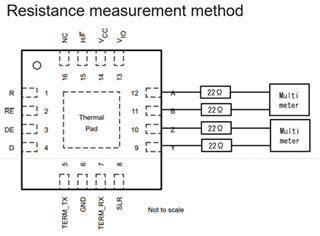Hello team,
I received questions from the customer.
Under the following conditions, only the highlighted area has a high resistance value, is this a problem? Communication is working even if the resistance is high.
| Half / Full duplex | Termination resistance configuration | TX(pair) | RX(pair) |
| Full | TX: ON, RX: ON | 10.18M ohm | 160.9 ohm |
| Full | TX: OFF, RX: OFF | 16.67M ohm | 124.3k ohm |
| Half | TX: ON, RX: OFF | 160.7 ohm | 298.6k ohm |
| Half | TX: OFF, RX: OFF | 109.5k ohm | 298.5k ohm |
Regards,
Masa


